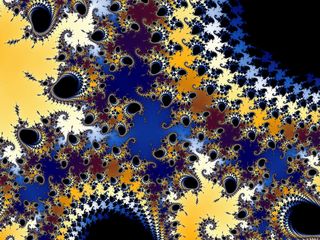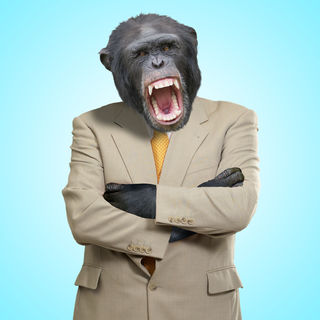What Makes the Human Brain “Human?” Part 1
What Makes the Human Brain “Human?” Part 1
How do our brains compare with the brains of other intelligent species?
What’s so special about the human
brain? What distinguishes the human brain from the brains of other
animals? These intriguing questions have been approached from many
directions, but here the focus is on brain complexity, a
feature that seems to be necessary (but not sufficient) for
consciousness to occur. Earlier posts have emphasized that the brain is a
genuine complex system (in a strict scientific sense); producing
dynamic (ever changing) patterns and sub-patterns of electrical and
chemical activity.
The familiar TV maps of temperature, rainfall, and other weather patterns over the earth’s surface provide useful metaphors that help us imagine changing patterns within the brain. The accompanying image demonstrates a fractal pattern or map. The image looks quite different at different levels of magnification; such fractal-like feature may be essential to brain complexity.
 This blog post centers on relationships between brain structures and
the (fractal-like) “patterns of mind” that our brains produce; these are
the so-called conscious correlates or signatures of consciousness.
Brains are complex and evidently human brains are, in some poorly
understood sense, more complex than other animal brains. Some writers
have even described the human brain as “the most complex object in the
universe,” but it seems unlikely that such pundits are sufficiently
well-traveled to defend this claim. In opposition, one might argue that
the earth’s seven billion interacting brains form a system that is far
more complex than any single brain.
This blog post centers on relationships between brain structures and
the (fractal-like) “patterns of mind” that our brains produce; these are
the so-called conscious correlates or signatures of consciousness.
Brains are complex and evidently human brains are, in some poorly
understood sense, more complex than other animal brains. Some writers
have even described the human brain as “the most complex object in the
universe,” but it seems unlikely that such pundits are sufficiently
well-traveled to defend this claim. In opposition, one might argue that
the earth’s seven billion interacting brains form a system that is far
more complex than any single brain.
Consciousness is far from an all or nothing condition; it does not work like a light switch that just goes on and off. Rather it’s more like a light with brightness controlled by a dimmer switch. In brains, the “dimmer switches” of consciousness are provided by various chemical (neuromodulator or hormone) systems. Humans experience graded states of consciousness when drowsy, under the influence of alcohol, dreaming, and in various stages of mental illness or Alzheimer’s disease. Furthermore, consciousness and (apparently) free will are strongly influenced by a number of partly independent subconscious systems.
Studies of consciousness may employ a model proposed by neuroscientist Antonio Damasio. The model consists of three hierarchical layers that are anchored in evolutionary influences: (1) The protoself represents a pre-conscious state shared by all life forms including single celled organisms; it provides an essential foundation for the two higher stages of “self” to build on. (2) Core consciousness occurs when organisms develop a sense of self. Core consciousness is concerned only with the present moment, the here and now. It does not require language or memory; nor can it reflect on past experiences or project itself into the future. (3) Extended consciousness occurs when awareness moves beyond the here and now and employs extensive use of memory. It becomes aware of past, present, and future.
 With these categories in mind, one can guess that many animals
possess core consciousness, but perhaps most animals lack the extended
consciousness of humans. Higher animals like the nonhuman great apes
(orangutans, gorillas, and chimpanzees) may possess lesser (but
nevertheless extended) consciousness. The great apes (and even crows and
octopuses) use tools, solve problems, and exhibit many other human-like
behaviors. One might naturally ask what distinguishes human brain
anatomy from the brains of the great apes and other mammals. This
question presents an apparent paradox—mental processing, indeed most of
our conscious experience, depends critically on operations of the
cerebral cortex—the outer brain layer having the approximate thickness
of a nickel. But there is very little difference between the cortical
structures of different mammals; all contain similar cell types arranged
in columns with distinct cortical layers.
With these categories in mind, one can guess that many animals
possess core consciousness, but perhaps most animals lack the extended
consciousness of humans. Higher animals like the nonhuman great apes
(orangutans, gorillas, and chimpanzees) may possess lesser (but
nevertheless extended) consciousness. The great apes (and even crows and
octopuses) use tools, solve problems, and exhibit many other human-like
behaviors. One might naturally ask what distinguishes human brain
anatomy from the brains of the great apes and other mammals. This
question presents an apparent paradox—mental processing, indeed most of
our conscious experience, depends critically on operations of the
cerebral cortex—the outer brain layer having the approximate thickness
of a nickel. But there is very little difference between the cortical
structures of different mammals; all contain similar cell types arranged
in columns with distinct cortical layers.
Larger brains will, of course, employ more neurons and columns to interact with one another. While brain size must count for something, it fails to explain why humans seem more intelligent than elephants, dolphins, and whales, at least based on our biased human measures. Whales have not developed advanced technologies or even constructed moderately sophisticated tools, but maybe they just have better things to do. These three large species all have brains covered by folded cortices that look much like human brains except they are larger—much larger in several whale species. While humans may enjoy the largest ratios of brain weight to body weight, such measure contributes little to the fundamental question of why human brains produce much more complex behavior. I have gained weight since high school, but I don’t think this has made me dumber; rather it’s probably the other way around.
Future posts of “What Makes the Human Brain “Human?” will employ general knowledge about other complex systems to suggest possible ways in which human brain anatomy and physiology may have evolved to generate more complex patterns than those produced by other animals. In particular, the nested hierarchy of cortical tissue and the preponderance of (long) “small world” connections in the human brain appear to be excellent candidates for producing complex brain patterns. One can then check the complexity-based speculations against established neuroscience to judge whether or not they seem scientifically plausible, that is “brain friendly.” This thought process may then suggest helpful new insights into the deep mystery of consciousness.
The familiar TV maps of temperature, rainfall, and other weather patterns over the earth’s surface provide useful metaphors that help us imagine changing patterns within the brain. The accompanying image demonstrates a fractal pattern or map. The image looks quite different at different levels of magnification; such fractal-like feature may be essential to brain complexity.

Source: canstockphoto 26401185 Mandelbrot set
Consciousness is far from an all or nothing condition; it does not work like a light switch that just goes on and off. Rather it’s more like a light with brightness controlled by a dimmer switch. In brains, the “dimmer switches” of consciousness are provided by various chemical (neuromodulator or hormone) systems. Humans experience graded states of consciousness when drowsy, under the influence of alcohol, dreaming, and in various stages of mental illness or Alzheimer’s disease. Furthermore, consciousness and (apparently) free will are strongly influenced by a number of partly independent subconscious systems.
Studies of consciousness may employ a model proposed by neuroscientist Antonio Damasio. The model consists of three hierarchical layers that are anchored in evolutionary influences: (1) The protoself represents a pre-conscious state shared by all life forms including single celled organisms; it provides an essential foundation for the two higher stages of “self” to build on. (2) Core consciousness occurs when organisms develop a sense of self. Core consciousness is concerned only with the present moment, the here and now. It does not require language or memory; nor can it reflect on past experiences or project itself into the future. (3) Extended consciousness occurs when awareness moves beyond the here and now and employs extensive use of memory. It becomes aware of past, present, and future.

Source: canstockphoto12341276
Larger brains will, of course, employ more neurons and columns to interact with one another. While brain size must count for something, it fails to explain why humans seem more intelligent than elephants, dolphins, and whales, at least based on our biased human measures. Whales have not developed advanced technologies or even constructed moderately sophisticated tools, but maybe they just have better things to do. These three large species all have brains covered by folded cortices that look much like human brains except they are larger—much larger in several whale species. While humans may enjoy the largest ratios of brain weight to body weight, such measure contributes little to the fundamental question of why human brains produce much more complex behavior. I have gained weight since high school, but I don’t think this has made me dumber; rather it’s probably the other way around.
Future posts of “What Makes the Human Brain “Human?” will employ general knowledge about other complex systems to suggest possible ways in which human brain anatomy and physiology may have evolved to generate more complex patterns than those produced by other animals. In particular, the nested hierarchy of cortical tissue and the preponderance of (long) “small world” connections in the human brain appear to be excellent candidates for producing complex brain patterns. One can then check the complexity-based speculations against established neuroscience to judge whether or not they seem scientifically plausible, that is “brain friendly.” This thought process may then suggest helpful new insights into the deep mystery of consciousness.

